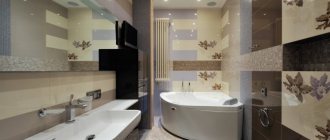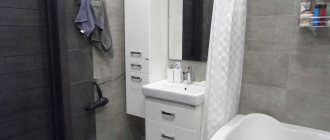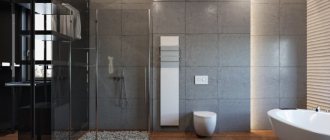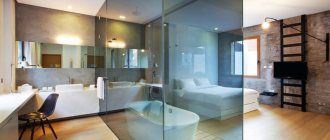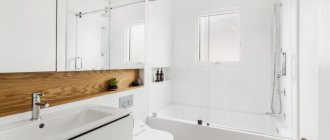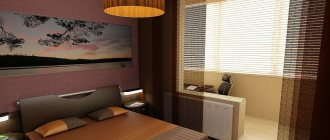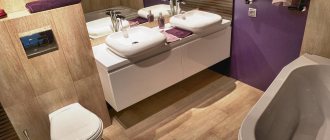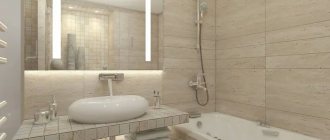Advantages of choosing a design
The design of a bathroom with a corner bath, undoubtedly, optimally combines with any interior style (irreplaceable classics, strict Scandinavian style, minimalism and hi-tech). The obvious advantages of choice include:
- Compact sizes. Corner furniture fits perfectly into the design of the room, occupying only one of the corners.
- Possibility to equip a room with a non-standard shape.
- A large number of additional devices, such as armrests, headrests, steps and levels. Families with children or elderly people, for whom steps and levels allow for safe bathing, should consider purchasing a corner bathtub.
- Some models of corner baths are additionally equipped with functions such as hydromassage, lighting with different colors of light, and water filtration.
The advantages include a large assortment of corner structures, varying in shape, size, and style. As part of modern interior styles, “smart” multifunctional appliances are welcomed. The design of a combined wall-hung bathroom with a corner bath is interesting - a combination of practicality, comfort and laconic style.
Installing an asymmetrical bathtub
No matter what anyone says, installing a bathtub with asymmetrical shapes is a rather labor-intensive process. Most often it is trusted to professionals from specialized companies. If you are confident in your abilities and decide to install the plumbing yourself, the instructions below will be useful.
Installing asymmetrical plumbing is a troublesome task, but doable
- First, study the attached installation recommendation, which comes with any product . Carefully read the package and the list of parts required for installation.
- Carefully examine the space reserved for the bath . Installation should begin only after you make sure that the floor and walls are level. If any defect is found, it should be eliminated using plaster or leveling mixture.
- Check the water drainage and intake system for suitability . Replace it if necessary.
Carefully connect plumbing fixtures to the water supply and drainage system
- Install a new bathtub , adjust its height using the legs.
- Connect the plumbing to the water supply and drainage system.
- Fill all existing gaps between the sides of the bathtub and the walls with silicone , and attach special waterproof sides on top.
Later, if desired, a curtain is hung near the bathtub, and the structure itself is used for its intended purpose.
Optimal selection criteria
When purchasing a corner bathtub, future owners should pay attention to the following criteria:
- Dimensions of the structure and its shape. It is better to compare the available area and the dimensions of the future purchase in advance.
- Features of fastening and connecting communication lines.
- The presence or absence of additional accessories (handles, steps, grilles). Handles, borders, and mats can protect against falling and injury.
Be sure to pay attention to the quality of the purchased model, strength, presence or absence of defects, chips, cracks.
Main types of corner baths
Manufacturers of sanitary ware and bathroom furniture are constantly expanding the range of supplied goods. You can choose a design based on your own preferences, features of the material used, and design.
The following types of corner baths are distinguished:
- Original models made of cast marble.
- Acrylic baths.
- Steel and cast iron models.
- Plastic options.
Depending on the type of construction, all baths are divided into the following groups:
- Baths on the podium.
- Stylish models with supporting legs.
- Asymmetrical and semicircular furniture options.
- Models with doors, glass curtains, and a protective screen.
The design of a corner bath combined with a shower stall and toilet is very advantageous. Each presented model has a number of advantages, disadvantages and practical features.
Acrylic bathtub sizes
The main requirement when choosing a size is ease of use. Dimensional parameters of acrylic bathtubs are offered within the following limits:
- Length: 1500, 1600, 1700, 1800 mm.
- Width: 700, 750 and 800 mm.
- Depth: ≥ 380 millimeters.
- Installation height of the structure: 0.6 meters with a tolerance of 20 mm on both sides.
Based on length and width, bathtubs are:
- Small - length within 1200-1300 mm, width up to 0.7 m.
- Average size – length 1400-1500, width up to 700 mm.
- Large bathtub – length 1700-1850 mm, width 700-850 mm.
TOP 3:
- Model range VitA, manufacturer – Polish company Cersanit.
- Collection of sanitary ware Georgia from the Spanish company Roca.
- Bathtub line "Catherine" from Bellrado, Russia.
In country houses, a round bathtub will become the main accent in the room - they are equipped with any functionality at the buyer’s request, so they can serve as a jacuzzi or hydro-air massage device. Heating, lighting, comfortable handrails and railings, other options and mechanisms are purchased separately.
Advantages:
- Acrylic is a material with low thermal conductivity, so water takes a long time to cool down.
The weight of the acrylic product is 40-50 kg . The medium weight allows the container to be easily mounted above the floor or built into a recess in the floor.
- Different shapes and colors suit any design.
A non-standard acrylic bathtub can be made according to individual projects, so it can have additional functionality - handrails, steps, a ledge for sitting, niches for accessories and other devices. Non-standard baths include standing and sitz baths, round or oval shapes.
Cast marble baths
These types of furniture are made from a special mixture of marble chips and acrylic compounds. The optimal combination of synthetic and natural materials gives the bathtub surface special strength, resistance to moisture, chemical detergents, and often mechanical damage.
The design of small corner bathtubs made of marble chips, which have an asymmetrical shape, is very advantageous.
What are the materials for making a bathtub?
Both the size, shape and type of bathtub must be adapted to the surface and parameters of the room, as well as to the individual preferences of the household. The use of the bathtub and the entire room should be comfortable and safe. A hygiene room is an investment for many years, so its purchase needs to be thought through very carefully. Currently, the choice is huge, one might say unlimited. It’s not for nothing that you still can’t decide on a specific model. Bathtubs available in the market differ mainly in the material from which they are made, shape (design), dimensions and method of assembly. First, let's look at the materials from which bathtubs are made. The most common in houses and apartments are:
Acrylic bathtubs - acrylic is a pleasant-to-touch material, always warm (which you will especially like in winter and early morning), and has good thermal insulation properties, thanks to which it retains hot water in the bowl longer. The result is a longer bath without the need to constantly add hot water, which ultimately results in significant savings and helps protect the environment. The acrylic surface will withstand a lot of children's play because it is scratch resistant. An additional advantage of acrylic is the ability to obtain interesting shapes, so today you can find bathtubs in such a material in completely unpredictable patterns. Acrylic bathtubs are relatively inexpensive, and after years of daily use, they can be completely refurbished for a small fee.
Conglomerate baths - conglomerate is an extremely durable material, resistant to scratches and various mechanical damage, and is very easy to clean. This makes it ideal for the production of bathing bowls. Conglomerate bathtubs are distinguished not only by functionality, but also by high aesthetics. They can be safely used in family bathrooms used by young children and older people.
Sanitary Composite Bathtubs - Composite is a mineral aggregate (such as a combination of quartzite and resin) that is highly resistant to scratches and discoloration. This allows manufacturers of bathroom solutions to create an unlimited number of models. Bathtubs made from composites have a designer, fresh shape, and thanks to the addition of acrylic resin, their surface is pleasantly warm to the touch and perfectly smooth.
Steel bathtubs - steel is characterized by maximum resistance to impacts and scratches. Steel bathtubs are made from thin sheet metal, making them lightweight. Their disadvantages are rapid heat loss and price. They can cost 2 times more than acrylic samples.
Each of the presented materials has its own characteristics: acrylic is warm and light, cast iron bathtubs are certainly durable, but also very heavy. Also important is the shape of the bathtub and the width of its rim, on which you usually place cosmetics used while bathing. When choosing a bowl, you should not rush, but you need to analyze every detail. Only then will you be sure that the bathtub is ideal for your hygiene room, fitting into the interior aesthetically and practically. All these elements are just as important for your everyday comfort in using the bathroom.
Steel structures
Corner bathtubs made of steel are very popular today. The plasticity and pliability of the material makes it possible to produce bathtubs of a wide variety of shapes and sizes, for example, bowls for two people.
Such structures are lightweight and therefore easy to move and install in practice. Those who like to soak in the bath should remember that an alloy of this type heats up easily and cools just as quickly.
What is the advantage over other baths?
An asymmetrical bathtub in the interior looks unusual
Any new product on the market has indispensable advantages over outdated analogues. Otherwise, the new product will not be in demand among consumers. The situation is the same with asymmetrical acrylic bathtubs.
The advantages of this miracle of plumbing include several points:
- Appearance. An asymmetrical bathtub in the interior looks unusual; the bathroom acquires individual features. Acrylic makes it easy to create designs with amazing shapes. An asymmetrical bathtub can be manufactured according to the customer’s conditions - any shape and any size;
- If the corner asymmetrical bathtub is made of acrylic, it is important to know that acrylic also retains its original shine well and for a long time. By periodically pouring hot water over your acrylic bathtub, you will ensure that its surface does not fade. The inner side always interacts with hot water, so no additional effort is required here (if the bath is of high quality, of course). Since asymmetrical new bathtubs are not cheap, this advantage is very significant;
- If suddenly the bathtub is scratched, or a small hole appears, you should know that an acrylic bathtub can be easily restored. Scratches, for example, can be polished with felt.
Bowls on supporting legs
For retro interior styles, a corner bathtub with support legs is perfect. This design is easy to care for; water and dirt will not accumulate under the bowl. Thanks to a well-thought-out system of supporting structures, the bathtub is quite stable, compact, functional, and can withstand significant loads.
A significant drawback is the inability to completely hide sewer pipes.
Advantages and disadvantages
Placing the bathtub in the corner can be a necessary measure or part of the design. The main thing is that expectations are met, and advantages and disadvantages can be found in any solution.
Advantages of a corner bath:
- Space saving.
- Attractive, often non-standard appearance.
- Convenience, functionality, practicality.
- Variety of modifications.
Possible disadvantages:
- A corner bath in a small bathroom can take up too much space, making it impossible to otherwise use not just one corner, but three at once.
- Some bowls increase water consumption due to their width.
- The price is higher.
- It is more difficult to install due to the non-standard design. Sometimes you have to level the corner and the walls.
Baths on the podium
An original model of a corner bath that fits perfectly into any interior style. The use of a special threshold visually increases the space of the bathroom and separates the bowl (and sometimes the toilet) from the rest of the room.
Using a podium in a room allows you to create an optimal layout, highlighting a storage area, installing a small pouf, and a cabinet with a built-in mirror.
Location examples
- The bathtub occupies a corner and completely one wall and partly the second - a sink is most often installed on it, and the latter can overhang a little. Ideal for a small room.
— A symmetrical bathtub occupies the main corner and looks beautiful from all sides. In the remaining space you can place a sink, toilet, washing machine and several cabinets.
— In the center of the room, taking into account a multi-level floor, is a very rare and extravagant solution, the implementation of which will require a lot of effort.
Bathroom design in black and white tones looks fashionable and modern
A corner bath will help save some space in a small room
See alsoWhy do you need a baseboard for a bath?
Bathtubs with shower
For small spaces, it is very reasonable to purchase a corner bath with a built-in shower stall. The advantages of choosing such a design include:
- Possibility to combine shower and bathing.
- Compact and significant space saving.
- Saving water.
- Design safety. All bowls of this type are additionally equipped with protective sides that limit the risk of falling.
Unfortunately, the combination of a bowl and a shower cabin does not entirely meet hygienic standards, which sometimes limits the choice of buyers. All models are equipped with protective screens or doors (usually made of matte plastic) that prevent water from entering the floor.
Bathroom options
There are a great many options for arranging a bathroom. It all depends on the area and layout of your apartment, as well as the requests of the owners. For example, someone is ready to give up a sink just to have a large bathtub, and they can wash their hands in it. Others will install a shower stall to create two bathrooms - a shower with toilet and sink in one, and a toilet with a small washbasin in the other.
The washing machine can also be placed both in the bathroom and in the kitchen if there is not enough space. There is a wide choice, so the main thing is to decide what you need.
See alsoWhat should be the design of a bathroom? We offer several important recommendations
